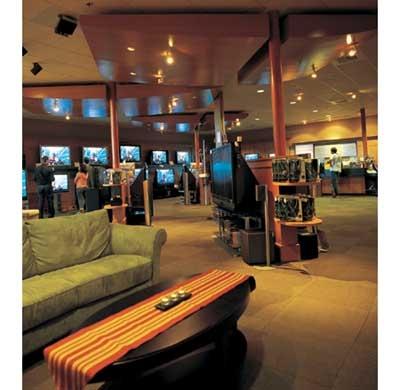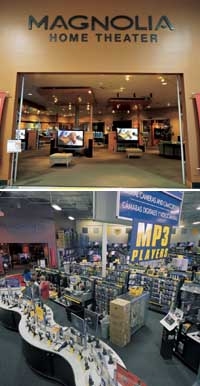What's in Store: Best Buy

Stepping up to the Red Octane Ignition dance pad hooked up to the Dance Dance Revolution game on an Xbox at the entrance to Best Buy's San Francisco store, I'm drawn into a pleasure palace of electronic entertainment. In the center aisle, rows of CDs fan back to the left, facing identical rows of DVDs on the right. Past the CDs, a middle-aged man uses an Xbox game controller to flick through weapon choices, preparing to take on a seemingly endless number of digitized Nazis in Medal of Honor. Further into the store, I line up with other customers at waist-high tables to touch, feel, and play with digital cameras, cellphones, iPods, and iPod wannabes.
Shopping here isn't about hunting down the latest gadget in a sea of boxed electronics, strapping it to the shopping cart, and racing to the cash register. Filled with an array of gear that ranges from MP3 players to high-end home theater systems, this Best Buy shouts that entertainment has become such a lifestyle that even the shopping experience needs to entertain.
 Many of the products that enable this lifestyle - including home theater and multiroom entertainment systems and home networks - are becoming more and more complicated. To ease the burden on customers who feel overwhelmed by the choices, Best Buy is trying to make high-tech solutions easier to assimilate into the go-go lives of gaming fanatics, home theater enthusiasts, and even soccer moms who want to sample the latest in electronic entertainment without sorting through all the latest gear.
Many of the products that enable this lifestyle - including home theater and multiroom entertainment systems and home networks - are becoming more and more complicated. To ease the burden on customers who feel overwhelmed by the choices, Best Buy is trying to make high-tech solutions easier to assimilate into the go-go lives of gaming fanatics, home theater enthusiasts, and even soccer moms who want to sample the latest in electronic entertainment without sorting through all the latest gear.
The retailing giant is charting a new course, putting the emphasis as much on customer service as on products, and its goal is both to simplify the shopping experience and (not surprisingly) to boost sales. Recognizing that it already had a strong handle on portable gear, entry-level A/V components, personal computers, entertainment software, and appliances, but didn't have an effective way to cater to the serious home theater enthusiast, Best Buy acquired the Seattle-based Magnolia Hi-Fi specialty chain in December 2000.
"Best Buy had been working toward what it calls 'customer centricity,' and this was an ideal fit," says Kris Peterson, VP of the Magnolia Home Entertainment and Design division. "They already had customers in their stores all the time buying CDs, DVDs, cellphones, and laptops, but these people weren't buying home theater systems there because they were buying them from us. So the executives at Best Buy started wondering, 'What if they still bought those systems from Magnolia, but inside of a Best Buy?'"
Best Buy has built Magnolia Home Theater ministores into more than 70 of its outlets and expected to have a total of 100 store-within-a-store complexes open by the end of 2005. Altogether, Best Buy has revamped about 250 of its 714 U.S. stores to add departments targeted at specific types of customers, from home theater buffs to small business owners, all staffed with sales consultants trained to help you come up with a custom-tailored system.
For example, if you say that you usually watch TV from an angle in a very bright room, but you also want a system that will blend into the space, a Magnolia consultant might recommend a wall-mounted, 42-inch Fujitsu plasma TV and suggest a surround sound system featuring a Denon DVD player and receiver and Definitive Technology speakers to go with it.
For $1,500, Magnolia will send one of its installers to your house to mount the TV and speakers on the wall, run all the necessary wires, and hook up all the components. If you want a universal remote control like the Harmony 880 ($250), there's also a charge for programming it. If you go with a "complete solution" that includes the gear, installation services, and recommended accessories, the system will cost about $7,500.
Make Yourself at Home In the cavernous San Francisco store, the hushed rooms of the 3,500-square-foot Magnolia Home Theater suite offer relief from the skull-throbbing sounds of videogame machinegun fire and blaring TVs. The area is a calming place with soft lighting, a low-slung ceiling, and carpeted floors. After browsing the rows of flat-panel TVs, I sit on a lichen-colored suede couch in the Magnolia area's main showfloor to check out a $22,000 home theater system featuring a $10,000 Pioneer Elite 61-inch plasma HDTV, a Denon AVR-3805 receiver ($1,000), a Denon DVD-2910 DVD player ($600), and a Vienna Acoustics speaker system ($6,120). All of the gear - including a $3,000 HP Media Center PC - rests on a $1,200 Salamander Designs stand.
In a room dedicated to music listening, called Studio 1, I kick back in a sleek $750 ChairWorks Italian-leather chair while Nora Jones croons "Come Away with Me" on speakers ranging from $200-a-pair bookshelf models to MartinLogan Mosaics selling for $999 apiece. There are many kinds of speakers on display, from traditional floorstanders to in-wall, ceiling, and outdoor models.
"Today's in-wall and ceiling models can sound really good," says John Tran, who manages the Magnolia area in the S.F. store, "and they free up over a square foot of floor space for each speaker - that's a lot of space in a San Francisco apartment."
- Log in or register to post comments



































































